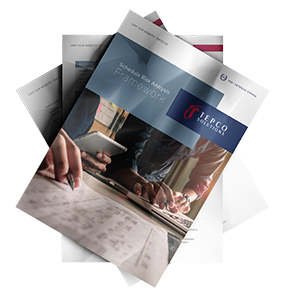
Schedule Risk Analysis Framework
 Know What to Expect
Know What to Expect
- Documentation Required
- Key Participants
- Software Utilized
- Timeline
- Workshop Process
- Deliverable Reporting
• Basic navigation
• Toolbars in Default Display
• How user preferences affect the project
• Setting user preferences
• Utilizing the Project Wizard
• Critical steps to know when beginning a project
• Understanding the Calendar Functionality
• Creating New Calendars
• Identifying Standard WBS
• Creating a WBS
• Utilizing the WBS
• Activity & Relationship Types
• Duration & Percent Complete Types
• Adding Activities
• Creating Activity Relationships
• Understanding Lag
• Creating Resources
• Managing Resources
• Understanding Group and Sort
• Understanding & Utilizing Filters
• Importing & Exporting Layouts
• Bars, Fonts and Row Heights
• Understanding Forward & Backward Pass Calculations
• Understanding Float & Critical Path
• Float
• Overview of the client integration of schedules
• Overview of the FEED & Detail Designs schedules and utilizing the template process
• Understanding the EPS
• Basic EPS build
• How user preferences affect the project
• Setting user preferences
• Utilizing the Project Wizard
• Creating new calendars
• Understanding the Calendar Funtionality
• Creating New Calendars
• Identifying Standard Engineering WBS
• Creating a WBS
• Utilizing the WBS
• Activity & Relationship Types
• Duration & Percent Complete Types
• Adding Activities
• Creating Activity Relationships
• Understanding Lag
• Building Code with Structure
• Creating Activity Codes at Different Levels
• Methods for Assigning Codes
• Creating Resources
• Managing Resources
• Reporting Resource Loaded Activities
• Understanding Group and Sort
• Understanding & Utilizing Filters
• Importing & Exporting Layouts
• Bars, Fonts, and Row Heights
• Understanding Baselines
• Creating Baselines
• Utilizing Baselines
• Understanding Float & Critical Path
• Free Float & Total Float
• Progressing Activities
• Schedule Log Files
• Report Window
• Running Reports
• Batch Reports
• Overview of client integration of schedules and where the construction and commissioning file fits in
• Overview of construction and commissioning schedule process and requirements
• Understanding the EPS
• Basic EPS build
• How user preferences affect the project
• Setting user preferences
• Utilizing the Project Wizard
• Creating new calendars
• Understanding the Calendar Functionality
• Creating New Calendars
• Identifying Standard CAP Project WBS
• Creating a WBS
• Utilizing the WBS
• Activity & Relationship Types
• Duration & Percent Complete Types
• Adding Activities
• Creating Activity Relationships
• Understanding Lag
• Building Code with Structure
• Creating Activity Codes at Different Levels
• Methods for Assigning Codes
• Creating Resources
• Managing Resources
• Reporting Resource Loaded Activities
• Understanding Group and Sort
• Understanding & Utilizing Filters
• Importing & Exporting Layouts
• Bars, Fonts, and Row Heights
• Understanding Baselines
• Creating Baselines
• Utilizing Baselines
• Understanding Float & Critical Path
• Free Float & Total Float
• Progressing Activities
• Schedule Log Files
• Report Window
• Running Reports
• Understanding Terminology and Process
• Schedule in Big Scheme
• Scheduling Values
• Understanding Primavera Structure
• Logging into Primavera
• User Preference Guide
• Toolbars & Menus
• Understanding & Saving Layouts
• Utilizing the Project Wizard
• Understanding Project Details & Settings
• Identifying Standard Turnaround WBS
• Creating a WBS
• Utilizing the WBS
• Understanding the calendar functionality
• Understanding Time Periods
• Creating new calendars
• Using the Activity Wizard
• Identifying Activity Types
• Adding Activities
• Creating Job Templates
• Activity Relationships
• Understanding Lag & Constraints
• Critical Path Method Scheduling
• Understanding Float & Critical Path
• Schedule Log Utilization
• Building Code with Structure
• Creating Activity Codes at Different Levels
• Methods for Assigning Codes
• Understanding Group and Sort
• Understanding and Utilizing Filters
• Importing & Exporting Layouts
• Bars, Fonts, and Row Heights
• Understanding Resources
• Creating Resource Pools
• Assigning Resources to Activities
• Viewing Resource Profiles
• Analyzing Schedule Dates
• Analyzing Critical Activities
• Analyzing Resource Allocations
• Understand Baselines
• Creating Baselines
• Utilizing Baselines
• Creating Look-Aheads
• Updating Activities
• Skills Required for Cost
• Cost Accountant Vs Cost Engineer
• Capital Vs Turnaround
• Review standard cost terminology
• Discuss Resource Planning, Cost Estimating, Cost Budgeting, and Cost Control.
• Why it is important
• Discuss each phase of the Turnaround Lifecycle
• Discuss each phase of the Turnaround Cost Lifecycle
• Discuss the 4 high-level cost groups and how each are defined.
• Discuss the importance of breaking each group out further and how it aligns with the schedule
• Discuss the different Estimates (Preparation, +/-50%, +/30%, +/-10%)
• Considerations for Development
• Estimate vs Budget
• Discuss Histogram
• Review Staffing Plan, Bid Sheet, & Estimate breakdown sheet.
• Discuss Purchase Orders & Control Budget
• Work Orders vs Purchase Orders
• Challenging vs Accepting estimates or bids
• Communication with timekeepers
• Onboarding meetings
• Building required spreadsheets
• High level review of Cost Report
• Discuss Daily Force Reporting
• Discuss Daily Timesheet Reporting
• Briefly discuss typical deliverables
• Briefly discuss the closeout process and activities
• Briefly review items covered in the basic class
• Discuss what each header on the Cost Report represents and how it is determined or calculated
• Discuss other data that is tracked on the Cost Report
• Discuss the purpose of baselining
• Building a Curve
• Discuss the purpose of Change Management
• Discuss how cost changes are determined and how they are communicated to the Cost Group
• Update Cost Report to reflect Change Work Requests
• Discuss type of Contracts
• Discuss methods for forecasting
• Update Forecast Curve
• Create Monthly forecast file for Accounting
• Discuss typical deliverables
• Create a Management Report
• Discuss the purpose of Accruals
• Create Accruals file for Accounting
• Discuss situations in which allocation to projects is necessary or required
• Create Allocation Percentages
• Create a monthly allocation file for Accounting
• Discuss responsibilities during closeout
• Discuss considerations during invoice reconciliation.
• Reconcile an Invoice
• Create PO Closeout Report